Lenovo ThinkStation P620 Review: A Vehicle for Threadripper Pro
by Dr. Ian Cutress on February 16, 2021 9:30 AM ESTBIOS and Software
As this is a custom system from a large OEM, the firmware inside is also very custom compared to consumer grade systems, and even enterprise systems. The big OEMs like Lenovo, Dell, or HP, often develop their own BIOS interfaces for the required option set, some even going as far as to enable a miniature operating system with bells and whistles, however more often than not with limited actual functionality that enthusiasts care about, typically wanting to lock that away so users can’t accidentally break it.
Lenovo to its credit does a much better job with its BIOS on the P620 than I’ve seen on a lot of other systems. Yes there is a custom interface, but it is very much just a modernized version of a simple text interface designed to look nicer with modern fonts. Unfortunately there was no screenshot option, and I've managed to get to 2021 without a capture device. So apologies for the photos of a monitor.
The menu options that are typically on the top of the BIOS screen are now down the side, and all the options we normally get are in the central console with a scroll down. What this design does (and why a lot of enthusiasts aren’t too fond of modern BIOS design) is that there’s a lot of extra white space everywhere, and there’s less information on a single screen. Luckily Lenovo has thought of that, and also offered a retro mode, which has exactly the same menu structure and offering as the initial fancy BIOS.
The BIOS itself gives all the standard chipset options of a regular system – enabling/disabling USB ports or networking or other IO, options to disable CPU performance modes, sleep modes, or SMT, a BIOS boot order, or choosing which PCIe slot has the primary video.
Also present in the BIOS is the professional level options, such as SR-IOV, Above 4G Decoding, RAS configuration for ECC and security, NUMA node selection, and Dash support.
These features were disabled when we first looked at the system, so admins looking to purchase them might request Lenovo do the necessary setup in advance. For business customers, they do things like that.
The fan settings, as we’ll discuss on the next page, are in the Power section.
In the security settings, there are a number of different password options due to the Pro-level nature of the workstation. What also surprised me is that there is an option to set the password encryption algorithm. Your choices are SHA-256 (standard) or SM3 (China), the latter of which is one of the Chinese cryptographic standard hashing algorithms. The other password options enable admins to set password length, password strength, and prevent BIOS rollback.
If there’s one thing I’d like, it would be a section on the screen that states what CPU is installed, how much memory, and perhaps the CPU temperature. The idea would be that this section would be on screen at all times, rather than having to hunt it down (CPU temperature isn’t actually listed in the BIOS anyway).
For users that know their way around a BIOS, Lenovo has made it relatively straight forward and easy.
Software
Before most people grown about the concept of OEM-level bundled software, Lenovo has done it right with this one. Aside from the background image when the user starts up, there is next to none. Lenovo’s sole program option is the Commercial Vantage application, allowing the user or admin to see the warranty length, probe Lenovo for system and driver updates, and offer links to online documentation/user guides. It’s unobtrusive and I couldn’t even find it at first, as Lenovo doesn’t even put its own name on it when searching for it.
I wish more vendors offered this little software. But this is perhaps a product of the professional nature of a system, whereas commercial systems for end-users there’s typically a kickback for an OEM to supply various software with it, or they are sold with particular anti-virus software etc.


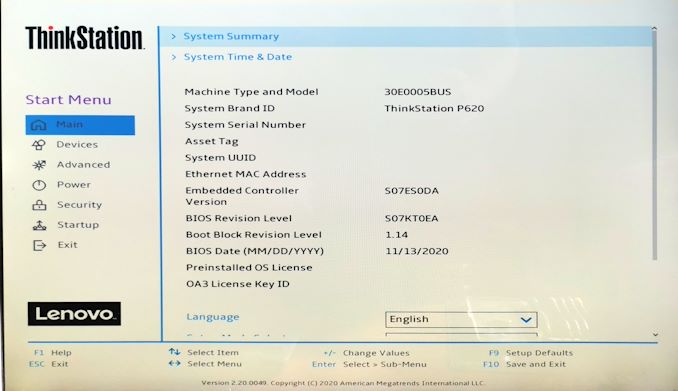
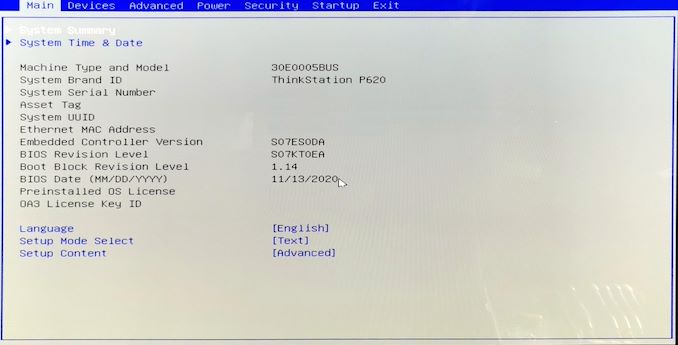
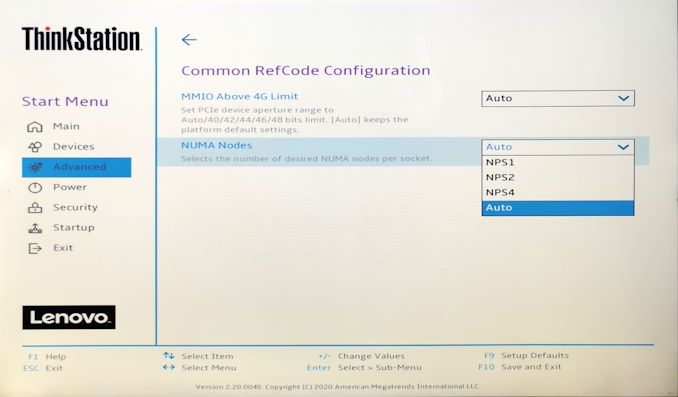

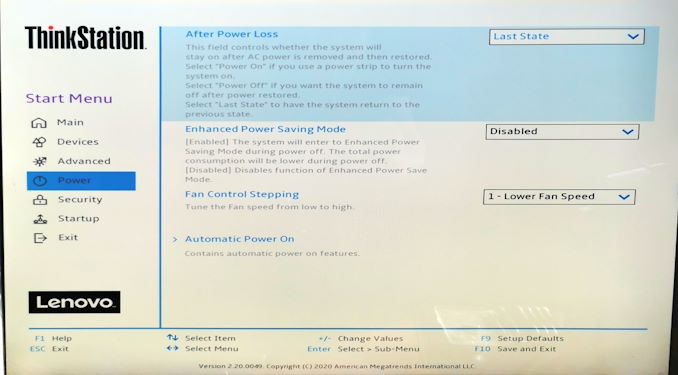
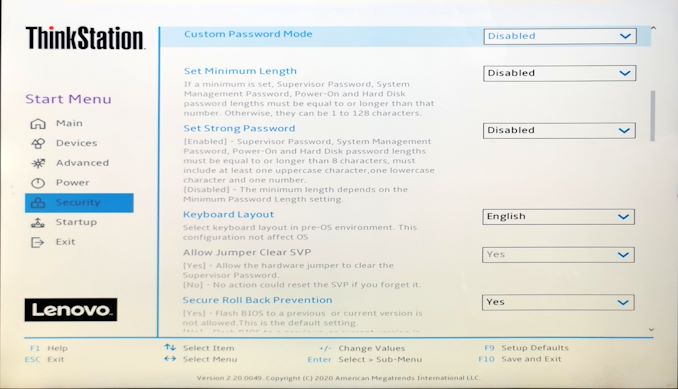
_thumb.jpg)
_thumb.jpg)
_thumb.jpg)
_thumb.jpg)
_thumb.jpg)
_thumb.jpg)
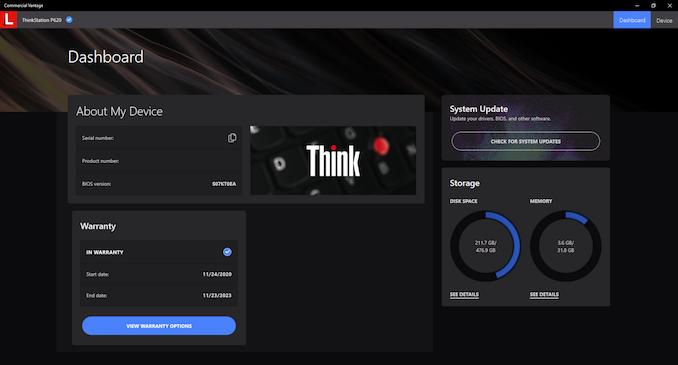








47 Comments
View All Comments
CranPars - Wednesday, February 17, 2021 - link
HP's Z workstations have long had many of the design points praised in this review, such as easy PCIe card retention, easy to remove fans, etc. Might be worth a look at them sometime.Spunjji - Wednesday, February 17, 2021 - link
They're still stuck on 14nm Intel CPUs, though.Spunjji - Wednesday, February 17, 2021 - link
Have to say, I *do* feel let-down by that final image on Page 1.Valantar - Friday, February 19, 2021 - link
I've always been impressed by the engineering of workstations like these, and this is no exception. 33 liters is significantly smaller than my old Fractal Define R4, and this houses a lot more (and more powerful) components while running cooler. It also shows just how great you can make your cooling if you design around it - some 92mm fans and some baffles, and you're able to effectively shunt nearly 600W of power (640W at 92% PSU efficiency = 589W internal power draw, the rest goes out the PSU) out with no issues, and quietly to boot.Consumer case designers definitely have something to learn here, though of course designing baffled and sectioned-off airflow is difficult when you don't know the socket positioning, CPU cooler used, etc. It's still a great demonstration of the efficiency of targeted design.
atlr - Saturday, February 20, 2021 - link
I think you are stating that kitting out 8 RDIMM sockets on a Lenovo order is cheaper than buying 3rd party RAM, but Lenovo's Feb-2021 price in the P620 configurator for 16 GB RDIMMs is US$300 per RDIMM which is about 3x higher than the open market. "The list price difference between a 2x16 GB arrangement and an 8x16 GB arrangement if you buy modules from the open market is $600-$1000 depending on where it is sourced. At the rates that Lenovo buys the memory, this is more likely to be nearer $200-$300. So why did Lenovo skimp on the memory for a system that is sold for nearer $20000? I have no idea. But the performance difference is so much more than the 1% price increase of filling it full of memory. This is something I want to report on, because it matters."atlr - Saturday, February 20, 2021 - link
correction:Lenovo 16GB RDIMM $266
Kingston 16GB RDIMM $107
Lenovo price ~2.5x
Snowleopard3000 - Sunday, February 28, 2021 - link
Let me know when you can fit all this in a Clevo so I can take it from one office to another office in a backpac....